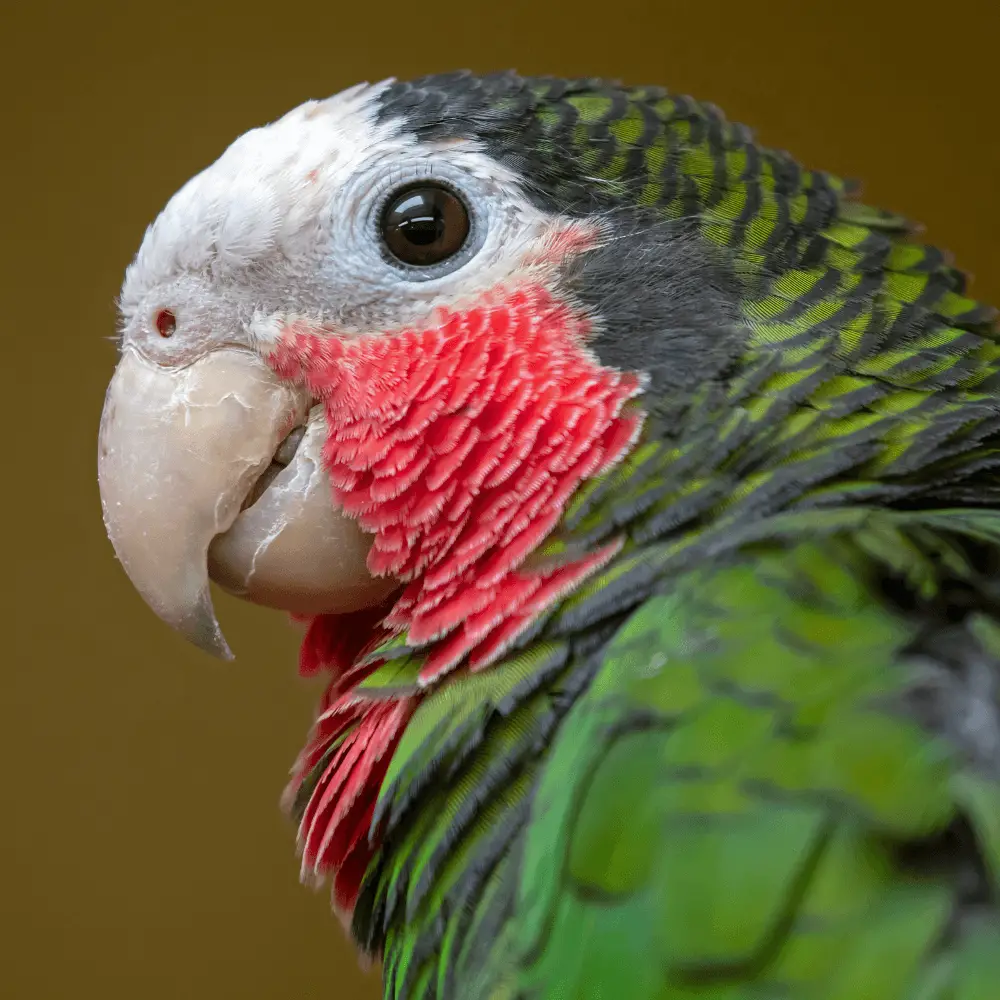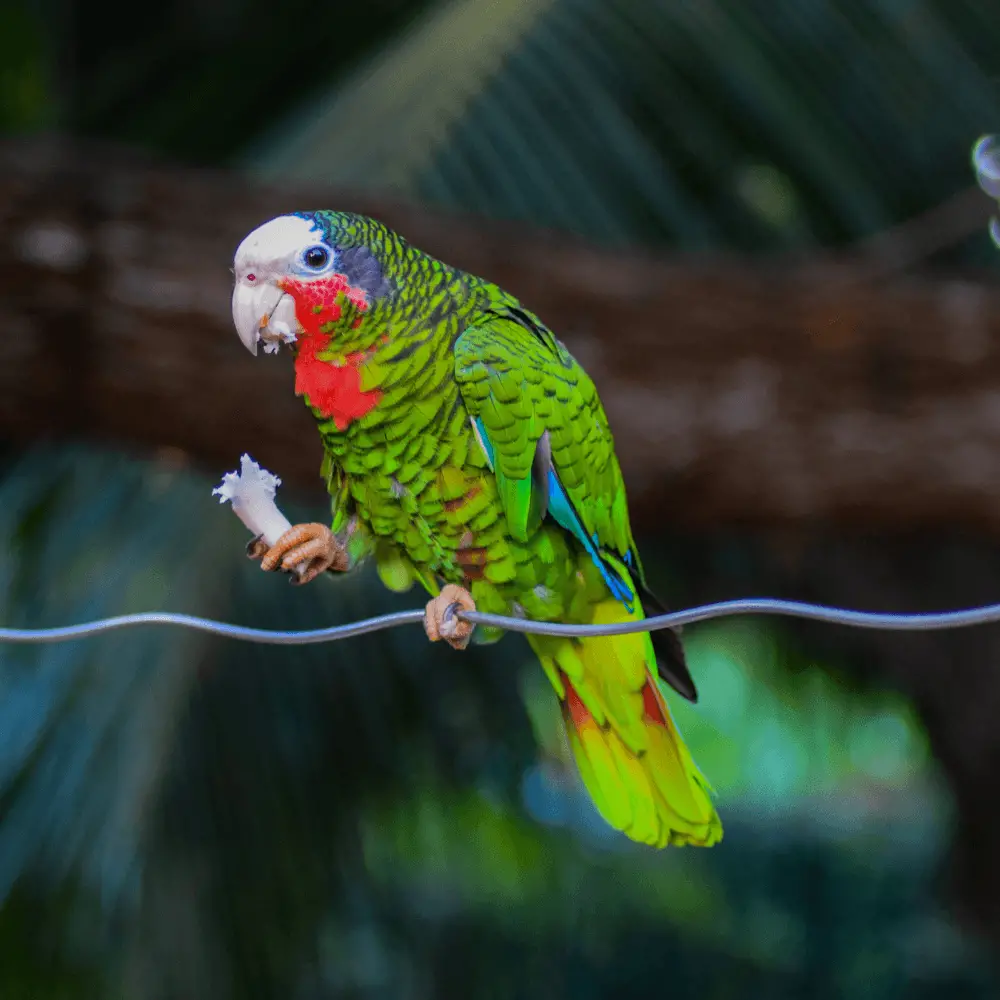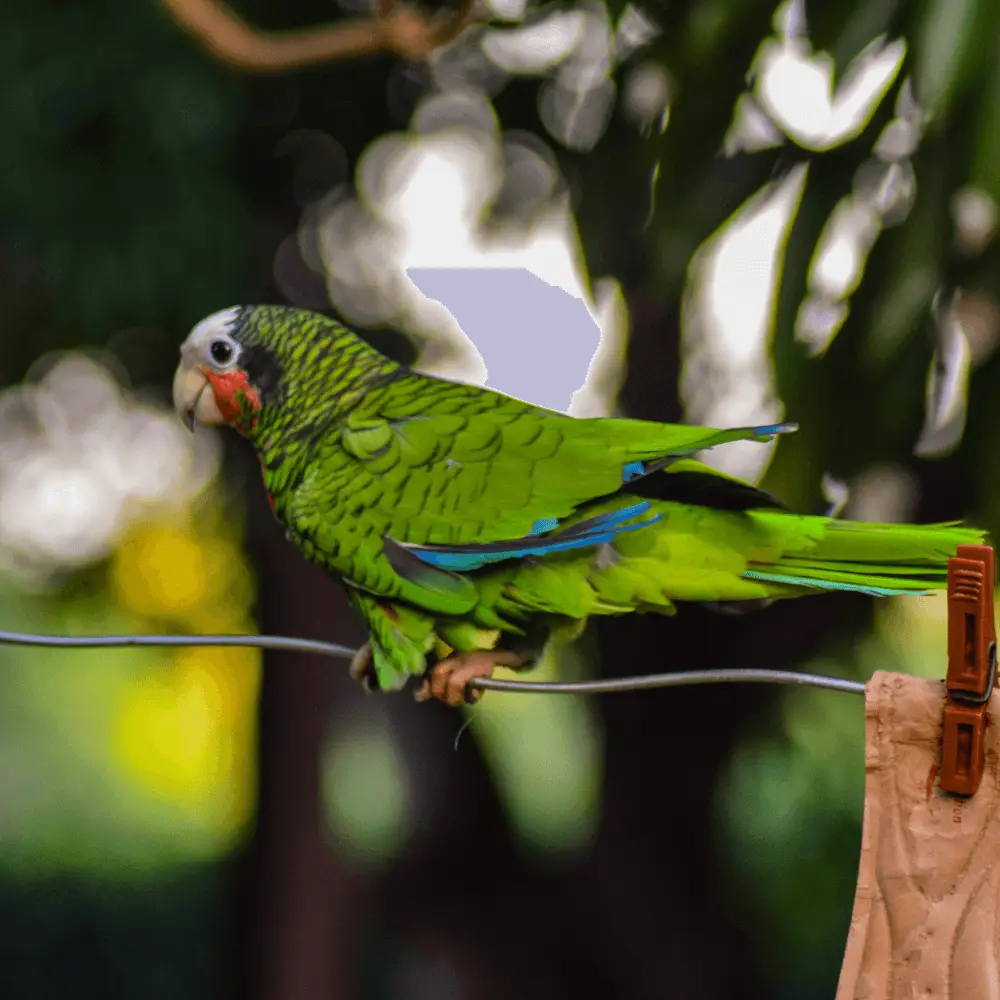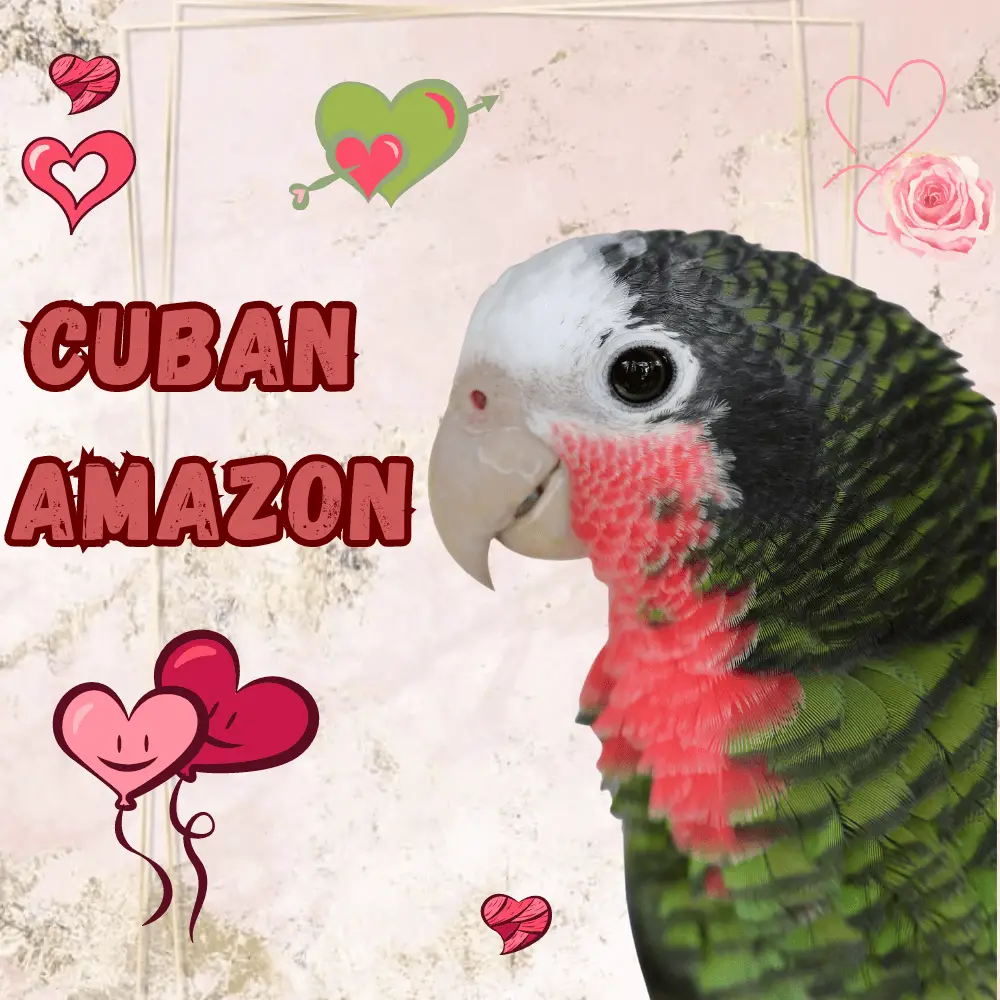Cuban amazon: 28-33cm. length and 260-301 grams. Know also as a rose-throated parrot(Amazona leucocephala) has a very variable plumage, a main color ranging from light green to olive color, some parrots have yellow feathers scattered on their wings and in the back.
Forehead, front of crown, lores, and area around eyes, White; lower cheeks Yes throat, pink-red; feathers at the back of the crown Yes nape, blue-green with black margins, giving the whole a strong forbidden effect; similar pattern on sides of the neck but with bluish tint absent; charcoal gray helmet ears.
Back feathers Yes mantle, green in color with black distal margins but less intense than in nape and head; Grupa Yes upper tail-coverts, dark green with faint margins to few grupa feathers.
Easy, large wings Yes flight feathers, blue in the external webs, internal gray; remaining coberteras with dark green margins, showing the lighter lesser covert restriction. Underwing, green with dark margins, gray flight feathers.
Chest green with dark margins on most feathers; feathers in the uterus with a wine-red base showing green on the margins forming a resizable patch, barely noticeable in some birds, most striking in others; thighs a few feathers of red or green wine; under tail-coverts green. tail feathers green with red at the base. Yellow-horn woodpecker: reddish-brown iris; yellowish-brown legs.
Both sexes are similar, but males of the Caymanenis subspecies are larger and brighter than females. Generally speaking, the immature show fewer black borders on the body feathers and less wine red in the belly.
- Order : Psittaciformes
- Family: Psittacidae
- Genus: Amazona
- Scientific name: Amazona leucocephala
- Quote : ( Linnaeus , 1758)
- Protonimo: Psittacus leucocephalus
-
Cuba, Bahamas, Cayman Islands
-
50-60 years.
-
28-33cm.
How many types of Cuban Amazon parrots are there?

Amazona leucocephala bahamensis
( Bryant, H, 1867) – Larger than the nominal species, slate blue on the back of the crown and more extensive white head. Pens wine red in the belly, diminished or absent, and red at the bottom of the less extended tail.
Amazona leucocephala caymanensis
( Cory, 1886) – It differs from the other subspecies by the turquoise coloring in the breast and in the Grupa and the suffusion rosacea (sometimes yellowish) in white feathers in the head.
Plumage Excluded yellower and less thick than the nominal species (particularly below and upper wing coverts), with less white in the head and a much less pronounced wine-red belly patch.
Amazona leucocephala hesterna
( Bangs, 1916) – Smaller and darker than the nominate species and than the caymanensis subspecies, most red-colored individuals are confined to a point below the eye Yes piece the smallest target crown, it has no the pinkish tint of the caymanensis subspecies. red wine piece in the belly larger than the Caymanensis subspecies.
Amazona leucocephala leucocephala
( Linnaeus, 1758) – Nominal.
Habitat

The Cuban Amazon inhabits different habitats on different islands. In Cuba They inhabit dense forests; in the Bahamas, in native hardwood forests and pine forests, and in the Cayman Islands, in dry forests in the plateau ridge and on nearby farmland ( Bond 1979, King 1981, Sibley y Monroe 1990 ).
Usually in small groups, but forages while forming larger groups in places where food is plentiful; pairs or in family groups in discernible herds. More often in pairs during breeding. They sleep communallyoutside the breeding season.
Distribution and status
The Cuban Amazon lives in Cuba, Island Pines, the Bahamas, and the Cayman Islands. Formerly observed throughout Cuba but now difficult to see or extinct in much of the island. They are still distributed locally in the provinces but they are still only common in a few redoubts, including the peninsulas of Zapata and Guanahacabibes and in Sierra de Sewage.
You can see this in the Ile des Pins ( àŽle de la jeunesse ) which fell dramatically during the 20th century, especially during the sixties, with most of the surviving population in Lanier Marécage National Park.
Formerly distributed by all major islands of the Bahamas, but currently extinct, except Gran Inagua (south, east, and north spread) Yes Abaco (especially in the southern third). You can visit Little Inagua from Great Inagua.
Mainly in central and eastern parts of Grand Cayman where habitat loss is less severe. A remnant Caiman Brac population persists but it disappeared in Little Cayman about 1932.
Mainly resident, but with some seasonal movements, for example in the Isle of Youth, where the birds eventually (at least once) moved to the coast from the dry interior outside the breeding season.
The decline across the range is due to the destruction and capture of live bird habitat (for use as local pets and for export).
Poor breeding success in Grand Cayman in the 1970s was due to mosquito attacks on the pups. Ground-nesting Abaco birds attacked by feral cats. Hurricanes can cause shortages of feeding and nesting sites. It is likely that the Bahamas are stable, but generally decreasing. You cannot be considered safe in most of its range.
How often do Cuban Amazons breed?

The Cuban Parrot makes their nests in cavities or hollows of palm trees created by termites or woodpeckers. The population of Abaco is particularly interesting because the nests are in natural holes in the limestone substrate in the ground ( O’Brien et al., 2006 ); there, chicks and adults are completely isolated from the frequent fires in the pine forests They form their habitat.
Reproduction March to mid-summer Cuba Yes Abaco. The setting generally includes between 2 Yes 4 eggs, the incubation period lasts 26 to 28 days and the chicks remain in the nest between 56 and 60 days.
What do Cuban parrots eat?

The diet includes yema leaf Roystonea, the cones and tender new shoots, the Pinus caribea , sea grape uvifera Y Conocarpus erretis, fruits and seeds of Smilax, Sabal, Durant, Exothea, Ernodea, Tabebuia, Acacia, Metopium, Tetrazygia, Swietenia, Cupania Yes Lisiloma. Sometimes they are persecuted for damage to cultivated fruits like Mango ( Mangifera ) and grain.
Are Cuban Amazons endangered?
The Rationale for Red List Category
The Cuban Parrot It is classified as Near Threatened because it is believed to have suffered a population reduction in Cuba, which has not stopped, mainly due to the capture and destruction of nesting sites.
• Current IUCN Red List Category: Near Threatened.
• Demographic trend: Degressive.
• Population size: 13600-23000

Population justification
Population estimates for the Bahamas and the Cayman Islands are as follows: 2,000 in Grand Cayman in 1995 ( Bradley 2000 ), about 450 in Cayman Brac in 2013 ( Marsden, 2013 ), 8,000-13,000 in Great Inagua, 3,000-5,000 in Abaco and about 10 individuals in New Providence ( Bahamas National Trust 2016, S. Cant-Woodside in a bit., 2016 ).
It is estimated that the population of Cuba amounts to 7,000 to 14,000 specimens based on recorded population density estimates and the fact that it is likely only part of the estimated extent of the case occurrence.
Therefore, the total population is estimated at 20,460-34,460 individuals, which equates to 13,640-22,973 mature individuals, rounded here to 13,600-23,000 mature individuals.
Justification of the trend
The species is considered to be in decline primarily due to the capture and destruction of nesting sites. It is considered that the population of the Bahamas has remained stable or has increased.
The population of the Cayman Islands has increased since the species was protected in 1989 ( Bradley 20000 ). It is believed that the Cuban population has decreased in recent years, mainly attributable to poaching ( Canizares 2012, M. Canizares in a bit., 2016 ).
Although there are no data on the extent of this decline, the species has been listed as Vulnerable in Cuba (Canizares 2012 ). Therefore, the total population is suspected to have declined by 10-20% over three generations.
Cuban Amazon in captivity
International trade Currently Cuban Amazon is prohibited by law; however, at the regional level, illicit trafficking This species is one of the most worrying Cuba.
Each captive specimen of this species, which is capable of reproducing, should be placed in a well-managed captive breeding program and not sold as a pet, to ensure its long-term survival.
SOURCE:Apollo and Frens
Related article:
- Red-crowned amazon
- Blue-cheeked Amazon
- Diademed Amazon
- Blue fronted amazon
- Amazon parrot for adoption
- Vinaceous-breasted amazon
- White-fronted amazon
- Lilac-crowned amazon
- Red-lore amazon
- Yellow-crowned amazon
- Double yellow headed amazon
- Green-cheeked Parrot
- Yellow-naped Amazon
- Hispaniolan Amazon
- Red-necked amazon

